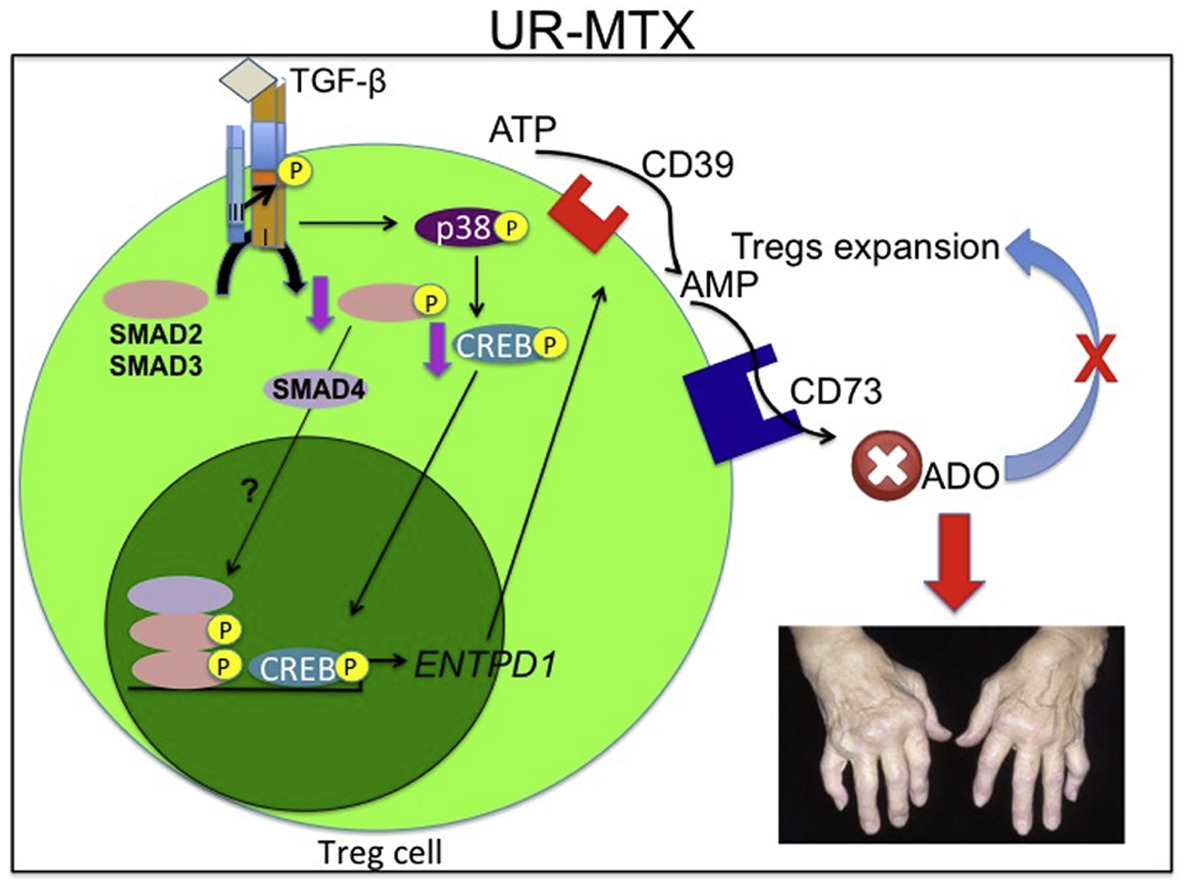TGF-β signalling defect is linked to low CD39 expression on regulatory T cells and methotrexate resistance in rheumatoid arthritis.
Rheumatoid arthritis (RA) is an autoimmune arthropathy characterized by chronic articular inflammation. Methotrexate (MTX) remains the first-line therapy for RA and its anti-inflammatory effect is associated with the maintenance of high levels of extracellular adenosine (ADO). Nonetheless, up to 40% of RA patients are resistant to MTX treatment and this is linked to a reduction of CD39 expression, an ectoenzyme involved in the generation of extracellular ADO by ATP metabolism, on circulating regulatory T cells (Tregs). However, the mechanism mediating the reduction of CD39 expression on Tregs is unknown. Here we demonstrated that the impairment in TGF-β signalling lead to the reduction of CD39 expression on Tregs that accounts for MTX resistance. TGF-β increases CD39 expression on Tregs via the activation of TGFBRII/TGFBRI, SMAD2 and the transcription factor CREB, which is activated in a p38-dependent manner and induces CD39 expression by promoting ENTPD1 gene transcription. Importantly, unresponsive patients to MTX (UR-MTX) show reduced expression of TGFBR2 and CREB1 and decreased levels of p-SMAD2 and p-CREB in Tregs compared to MTX-responsive patients (R-MTX). Furthermore, RA patients carrying at least one mutant allele for rs1431131 (AT or AA) of the TGFBR2 gene are significantly (p = 0.0006) associated with UR-MTX. Therefore, we have uncovered a molecular mechanism for the reduced CD39 expression on Tregs, and revealed potential targets for therapeutic intervention for MTX resistance.
Authors
Raphael S Peres; Paula B Donate; Jhimmy Talbot; Nerry T Cecilio; Patricia R Lobo; Caio C Machado; Kalil W A Lima; Rene D Oliveira; Vanessa Carregaro; Helder I Nakaya; Thiago M Cunha; José Carlos Alves-Filho; Foo Y Liew; Paulo Louzada-Junior; Fernando Q Cunha
External link
Publication Year
Publication Journal
Associeted Project
Microbiology or Immunology
Lista de serviços
-
Genomic analyses reveal broad impact of miR-137 on genes associated with malignant transformation and neuronal differentiation in glioblastoma cells.Genomic analyses reveal broad impact of miR-137 on genes associated with malignant transformation and neuronal differentiation in glioblastoma cells.
-
RNA-Binding Protein Musashi1 Is a Central Regulator of Adhesion Pathways in Glioblastoma.RNA-Binding Protein Musashi1 Is a Central Regulator of Adhesion Pathways in Glioblastoma.
-
MicroRNA Transcriptome Profiling in Heart of Trypanosoma cruzi-Infected Mice: Parasitological and Cardiological Outcomes.MicroRNA Transcriptome Profiling in Heart of Trypanosoma cruzi-Infected Mice: Parasitological and Cardiological Outcomes.
-
Genome mapping and expression analyses of human intronic noncoding RNAs reveal tissue-specific patterns and enrichment in genes related to regulation of transcription.Genome mapping and expression analyses of human intronic noncoding RNAs reveal tissue-specific patterns and enrichment in genes related to regulation of transcription.
-
Antimicrobial peptide LL-37 participates in the transcriptional regulation of melanoma cells.Antimicrobial peptide LL-37 participates in the transcriptional regulation of melanoma cells.
-
Down-regulation of 14q32-encoded miRNAs and tumor suppressor role for miR-654-3p in papillary thyroid cancer.Down-regulation of 14q32-encoded miRNAs and tumor suppressor role for miR-654-3p in papillary thyroid cancer.
-
Integration of miRNA and gene expression profiles suggest a role for miRNAs in the pathobiological processes of acute Trypanosoma cruzi infection.Integration of miRNA and gene expression profiles suggest a role for miRNAs in the pathobiological processes of acute Trypanosoma cruzi infection.
-
Integrative Biology Approaches Applied to Human DiseasesIntegrative Biology Approaches Applied to Human Diseases
-
Proteomics reveals disturbances in the immune response and energy metabolism of monocytes from patients with septic shock.Proteomics reveals disturbances in the immune response and energy metabolism of monocytes from patients with septic shock.
-
Genomics, epigenomics and pharmacogenomics of Familial Hypercholesterolemia (FHBGEP): A study protocol.Genomics, epigenomics and pharmacogenomics of Familial Hypercholesterolemia (FHBGEP): A study protocol.
-
Melatonin-Index as a biomarker for predicting the distribution of presymptomatic and asymptomatic SARS-CoV-2 carriersMelatonin-Index as a biomarker for predicting the distribution of presymptomatic and asymptomatic SARS-CoV-2 carriers
-
Profiling plasma-extracellular vesicle proteins and microRNAs in diabetes onset in middle-aged male participants in the ELSA-Brasil study.Profiling plasma-extracellular vesicle proteins and microRNAs in diabetes onset in middle-aged male participants in the ELSA-Brasil study.
-
Big Data and machine learning in cancer theranosticsBig Data and machine learning in cancer theranostics
-
Genomic positional conservation identifies topological anchor point RNAs linked to developmental loci.Genomic positional conservation identifies topological anchor point RNAs linked to developmental loci.
-
Integrative systems immunology uncovers molecular networks of the cell cycle that stratify COVID-19 severityIntegrative systems immunology uncovers molecular networks of the cell cycle that stratify COVID-19 severity

